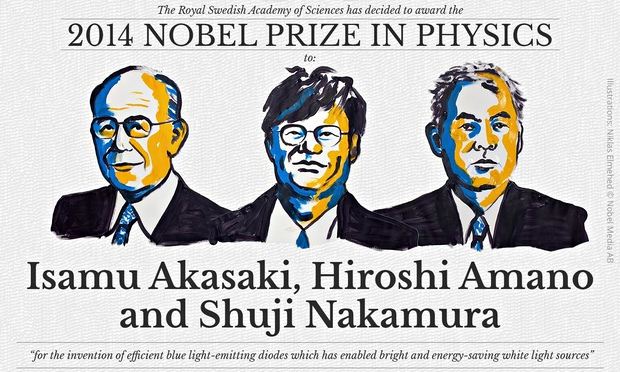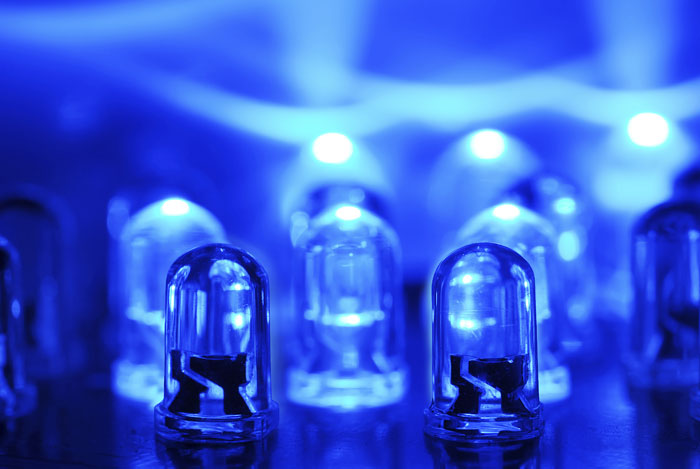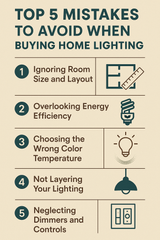LED Lighting Wins 2014 Nobel Prize in Physics

Image provided via the Guardian (www.theguardian.com)
LED lighting has revolutionized
residential and commercial lighting solutions, offering an energy efficient
technology that is more efficient, durable, long-lasting, and versatile than
both compact fluorescent and incandescent lighting. In fact, this technology is
so important that its inventors -- Hiroshi Amano, Shuji Nakamura, and Isamu
Akasaki -- were the recipients of the Nobel Prize in Physics in 2014 for the
creation of the blue LED diode, an extremely beneficial invention that enables
full spectrum of bright LED lighting.
The Invention of LED Illumination
White light requires LEDs (light-emitting diodes) that can deliver blue, green,
and red light. Red LED illumination was first created in the 1950s, with green
LED following in the 1960s. For decades, researchers struggled to create blue
LEDs.
In the 1980s, Amano and Akasaki working at Japan's Nagoya University and
Nakamura working with the Nichia Corporation focused their work on the compound
semiconductor gallium nitride (GaN), hoping it could be used to produce blue
LEDs. While other researchers had attempted this line of research in the past,
the three were separately able to break through numerous challenges. Nakamura
is credited with creating the first high-brightness blue LED light in 1993.
With their Nobel Prize in Physics, Amano, Akasaki, and Nakamura joined almost
200 illustrious peers. The Nobel Prize in Physics has also been awarded to
well-known scientists such as Peter W. Higgs for the theoretical discovery of
the subatomic particle (the "Higgs boson particle"), Victor Hess for
his discovery of cosmic radiation, and Albert Einstein for his multiple
contributions to theoretical physics.

Image provided via PhysicsWorld (www.physicsworld.com)
What Makes LED So Ground-Breaking?
Energy efficient lighting in the form of blue LED has been around for just 20
years, but it has already been used to create white light in a completely new
way that benefits everyone. White LED lights emit a bright white light. There
are several advantages to LED lighting that makes it worthy of the Nobel.
LED lamps last longer and use far less energy than any other form of lighting,
and the technology is continually improved, resulting in more efficiency with a
higher lumen per watt. LED lights just broke another record at more than 300
lm/W, compared to 16 lm/W for an incandescent light bulb and 70 for a
fluorescent lamp. LEDs can last for up to 100,000 hours, compared with 10,000
hours with fluorescents and just 1,000 for incandescents.
Another important LED advantage is they can emit light in a specific direction,
unlike fluorescent and incandescent lights. For this reason they have many
applications, from LED art lights and piano lights to replacements for standard
incandescent light bulbs. This technology does not radiate heat as a halogen or
incandescent bulb would, which is yet another reason they have become popular
as LED art lights, under-cabinet lights, and night lights.
Cost is a final important benefit. This energy efficient lighting has the potential
to save homeowners hundreds every month. By switching out 47 incandescent bulbs
for LED, for example, someone can save more than $40 per month in electricity
costs.
LED lighting has been around for just twenty years but it has already
transformed illumination solutions. With new improvements introduced each year,
LED technology will only get better with time.
For the best in LED Lighting Products, be sure to check out our art lights, barn lights, and piano lamps, all available from our website, cocoweb.com.
Recent Posts
-
Top 5 Mistakes to Avoid When Buying Home Lighting
Lighting plays a crucial role in shaping the ambiance, functionality, and aesthetic appeal of your h …26th Jun 2025 -
Why Lighting Is the Most Underrated Design Element in a Room
Walk into a well-designed space, and you might first notice the color of the walls, the statement fu …13th May 2025 -
How to Choose the Perfect Painting for Your Home or Office
When it comes to decorating your space, choosing the perfect painting can be a game-changer. A well- …7th Feb 2025



